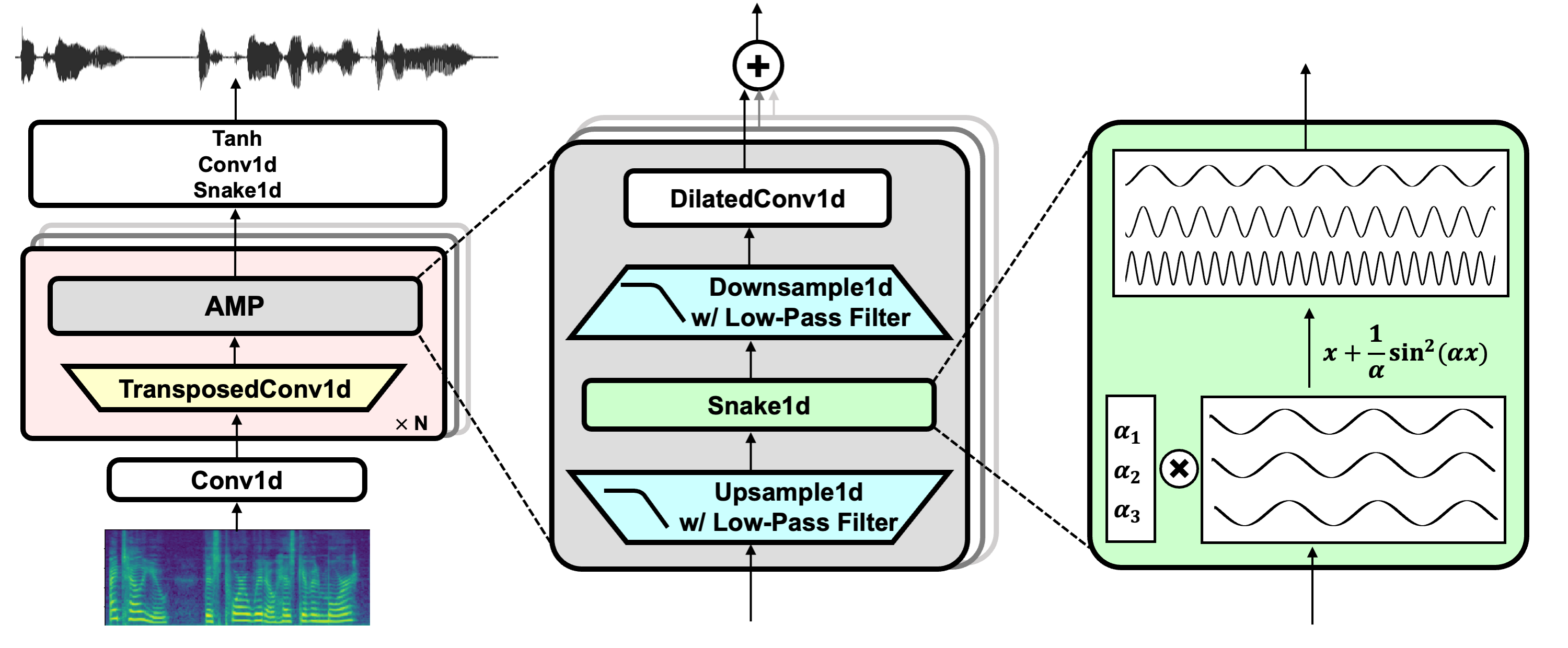Clone the repository and install dependencies.
# the codebase has been tested on Python 3.8 / 3.10 with PyTorch 1.12.1 / 1.13 conda binaries
git clone https://github.com/NVIDIA/BigVGAN
pip install -r requirements.txtCreate symbolic link to the root of the dataset. The codebase uses filelist with the relative path from the dataset. Below are the example commands for LibriTTS dataset.
cd LibriTTS && \
ln -s /path/to/your/LibriTTS/train-clean-100 train-clean-100 && \
ln -s /path/to/your/LibriTTS/train-clean-360 train-clean-360 && \
ln -s /path/to/your/LibriTTS/train-other-500 train-other-500 && \
ln -s /path/to/your/LibriTTS/dev-clean dev-clean && \
ln -s /path/to/your/LibriTTS/dev-other dev-other && \
ln -s /path/to/your/LibriTTS/test-clean test-clean && \
ln -s /path/to/your/LibriTTS/test-other test-other && \
cd ..Train BigVGAN model. Below is an example command for training BigVGAN using LibriTTS dataset at 24kHz with a full 100-band mel spectrogram as input.
python train.py \
--config configs/bigvgan_24khz_100band.json \
--input_wavs_dir LibriTTS \
--input_training_file LibriTTS/train-full.txt \
--input_validation_file LibriTTS/val-full.txt \
--list_input_unseen_wavs_dir LibriTTS LibriTTS \
--list_input_unseen_validation_file LibriTTS/dev-clean.txt LibriTTS/dev-other.txt \
--checkpoint_path exp/bigvganSynthesize from BigVGAN model. Below is an example command for generating audio from the model.
It computes mel spectrograms using wav files from --input_wavs_dir and saves the generated audio to --output_dir.
python inference.py \
--checkpoint_file exp/bigvgan/g_05000000 \
--input_wavs_dir /path/to/your/input_wav \
--output_dir /path/to/your/output_wavinference_e2e.py supports synthesis directly from the mel spectrogram saved in .npy format, with shapes [1, channel, frame] or [channel, frame].
It loads mel spectrograms from --input_mels_dir and saves the generated audio to --output_dir.
Make sure that the STFT hyperparameters for mel spectrogram are the same as the model, which are defined in config.json of the corresponding model.
python inference_e2e.py \
--checkpoint_file exp/bigvgan/g_05000000 \
--input_mels_dir /path/to/your/input_mel \
--output_dir /path/to/your/output_wavWe provide the pretrained models. One can download the checkpoints of generator (e.g., g_05000000) and discriminator (e.g., do_05000000) within the listed folders.
| Folder Name | Sampling Rate | Mel band | fmax | Params. | Dataset | Fine-Tuned |
|---|---|---|---|---|---|---|
| bigvgan_24khz_100band | 24 kHz | 100 | 12000 | 112M | LibriTTS | No |
| bigvgan_base_24khz_100band | 24 kHz | 100 | 12000 | 14M | LibriTTS | No |
| bigvgan_22khz_80band | 22 kHz | 80 | 8000 | 112M | LibriTTS + VCTK + LJSpeech | No |
| bigvgan_base_22khz_80band | 22 kHz | 80 | 8000 | 14M | LibriTTS + VCTK + LJSpeech | No |
The paper results are based on 24kHz BigVGAN models trained on LibriTTS dataset. We also provide 22kHz BigVGAN models with band-limited setup (i.e., fmax=8000) for TTS applications.
Current codebase only provides a plain PyTorch implementation for the filtered nonlinearity. We are working on a fast CUDA kernel implementation, which will be released in the future.
HiFi-GAN (for generator and multi-period discriminator): https://github.com/jik876/hifi-gan
Snake (for periodic activation): https://github.com/EdwardDixon/snake
alias-free-torch (for anti-aliasing): https://github.com/junjun3518/alias-free-torch
Julius (for low-pass filter): https://github.com/adefossez/julius
UnivNet (for multi-resolution discriminator): https://github.com/mindslab-ai/univnet
